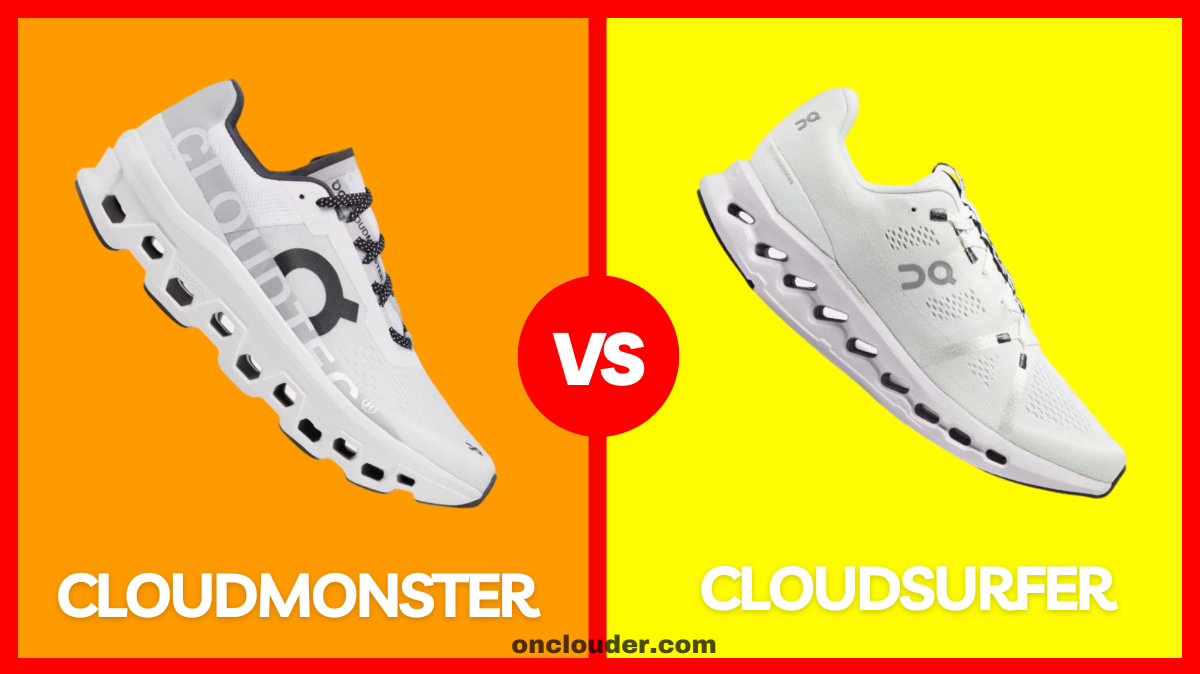If you’ve been eyeing On Running’s popular models, you might be wondering how the Cloudrunner and Cloudsurfer stack up against each other.
In this comprehensive guide, we’ll break down the key features of both shoes to help you make an informed decision.
On Running has made a name for itself with its innovative CloudTec® technology, but how do these two models differ?
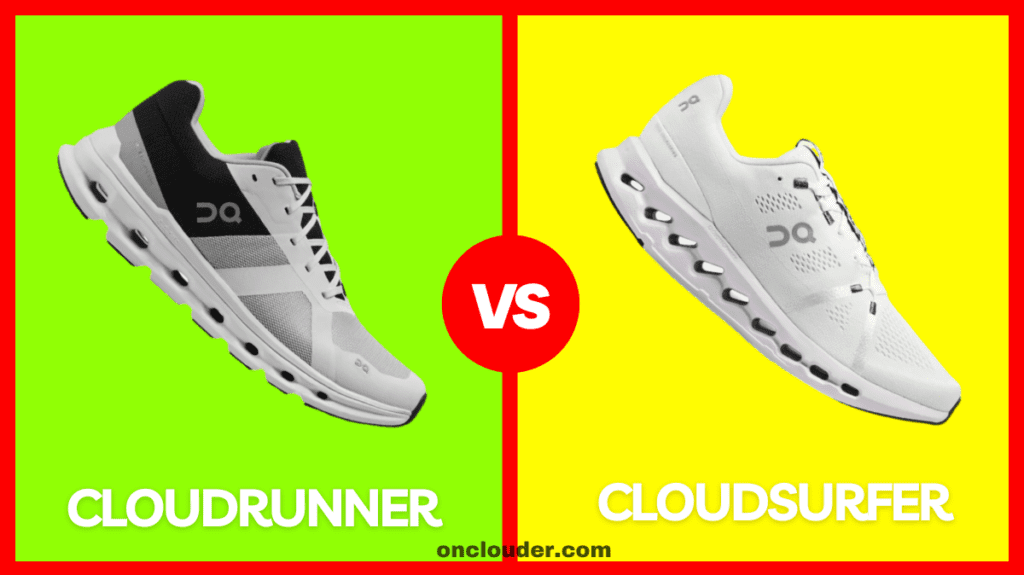
Contents
- 1 Cloudrunner vs Cloudsurfer Shoes
- 2 Which Shoes Perfect for Any Activity
- 3 Overview of Cloudrunner and Cloudsurfer
- 4 Durability: Built to Last
- 5 Breathing Easy: Ventilation and Breathability
- 6 Cushioning: The Heart of Comfort
- 7 Finding the Right Fit
- 8 Stability: Keeping You Steady
- 9 Comfort: All-Day Wearability
- 10 Quality: Built to Perform
- 11 Style: Looking Good on the Run
- 12 Size Matters: Finding Your Fit
- 13 Material Matters: What They’re Made Of
- 14 Weight: Light on Your Feet
- 15 Flexibility: Bend and Flex
- 16 Water Resistance: Staying Dry
- 17 Sole Purpose: Traction and Durability
- 18 User Reviews: Real Runner Insights
- 19 Price Comparison
- 20 Pros and Cons
Cloudrunner vs Cloudsurfer Shoes
The main difference between Cloudrunner and Cloudsurfer shoes lies in their design focus. Cloudrunner prioritizes comfort and stability for everyday runs, offering maximum cushioning and support. In contrast, Cloudsurfer is geared towards performance, providing a more responsive and lightweight feel for speed work and races.
Both feature On Running’s innovative CloudTec® technology but cater to different running preferences.
Now, let’s create a detailed comparison table for Cloudrunner vs Cloudsurfer Shoes:
| Feature | Cloudrunner | Cloudsurfer |
| Design Focus | Everyday comfort and stability | Performance and responsiveness |
| Cushioning | Maximum, softer foam | Balanced, firmer foam |
| Weight | Heavier (M: 10.4oz, W: 8.8oz) | Lighter (M: 9.7oz, W: 8.1oz) |
| Fit | Wider, more accommodating | Snugger, performance-oriented |
| Stability | High, with supportive features | Moderate, neutral support |
| Flexibility | Moderate | High |
| Durability | 400-500 miles | 300-400 miles |
| Breathability | Excellent | Excellent |
| Best For | Daily training, long runs | Speed work, racing |
| Pronation | Mild overpronation support | Neutral |
| Price (MSRP) | $149.99 | $159.99 |
| Upper Material | Engineered mesh | Lightweight mesh and synthetic |
| Midsole | Helion™ superfoam | Helion™ superfoam |
| Outsole | More rubber coverage | Strategic rubber placement |
| Water Resistance | Moderate | Minimal |
Summary: The Cloudrunner and Cloudsurfer cater to different running needs while both utilizing On Running’s CloudTec® technology. Cloudrunner excels in comfort, stability, and durability, making it ideal for everyday training and longer distances.
Cloudsurfer, being lighter and more flexible, is designed for speed and performance, suited for tempo runs and races. Your choice depends on your running style, goals, and personal preferences in cushioning and responsiveness.
Also Read: Cloud Monster vs On Cloudboom Echo 3
Which Shoes Perfect for Any Activity
For Running
Cloudrunner
- Versatile shoe suitable for various distances and daily training
- Moderate cushioning with CloudTec® and Helion™ superfoam
- Neutral support for runners with normal pronation
- Good for moderate paces and everyday runs
Cloudsurfer
- Designed for faster-paced runs and performance
- Higher level of responsiveness and energy return
- Lighter weight than Cloudrunner for quicker transitions
- Better suited for tempo runs and race days
For Walking
Cloudrunner
- Good for walking with responsive cushioning
- Engineered mesh upper provides breathability for longer walks
- Moderate cushioning may be sufficient for most walking needs
Cloudsurfer
- Less ideal for extended walking due to its performance-oriented design
- Firmer cushioning might be less comfortable for casual walks
- Lightweight construction could be beneficial for shorter walks
For Standing All Day
Cloudrunner
- Decent for standing with its moderate cushioning
- Neutral support may be sufficient for those without specific foot issues
Cloudsurfer
- Less suitable for all-day standing due to its performance focus
- Firmer cushioning may cause discomfort over extended periods
- Designed more for dynamic movements rather than static positions
Overview of Cloudrunner and Cloudsurfer
Before we get into the nitty-gritty, let’s start with a quick overview of each shoe:
Cloudrunner: The Cloudrunner is designed for everyday runs and long-distance comfort. It’s built to provide maximum cushioning and support for runners who want a soft, stable ride.
Cloudsurfer: The Cloudsurfer is geared towards performance-oriented runners looking for a responsive shoe that can handle speed work and races. It offers a blend of cushioning and energy return.
Now, let’s break down the key features of both shoes:
Durability: Built to Last
When investing in running shoes, durability is a crucial factor. Let’s see how the Cloudrunner and Cloudsurfer hold up:
Cloudrunner Durability
The Cloudrunner is engineered for longevity. Its outsole features:
- Reinforced rubber pads in high-wear areas
- Durable CloudTec® elements that maintain their shape over time
- A robust upper material that resists tearing and fraying
Many runners report getting 400-500 miles out of their Cloudrunners before noticing significant wear.
Cloudsurfer Durability
The Cloudsurfer, while still durable, is designed with performance in mind:
- Lightweight materials may show wear slightly faster than the Cloudrunner
- Strategic placement of rubber on the outsole for traction and longevity
- Reinforced toe box to prevent early breakdown
Expect to get 300-400 miles from your Cloudsurfers, depending on your running style and terrain.
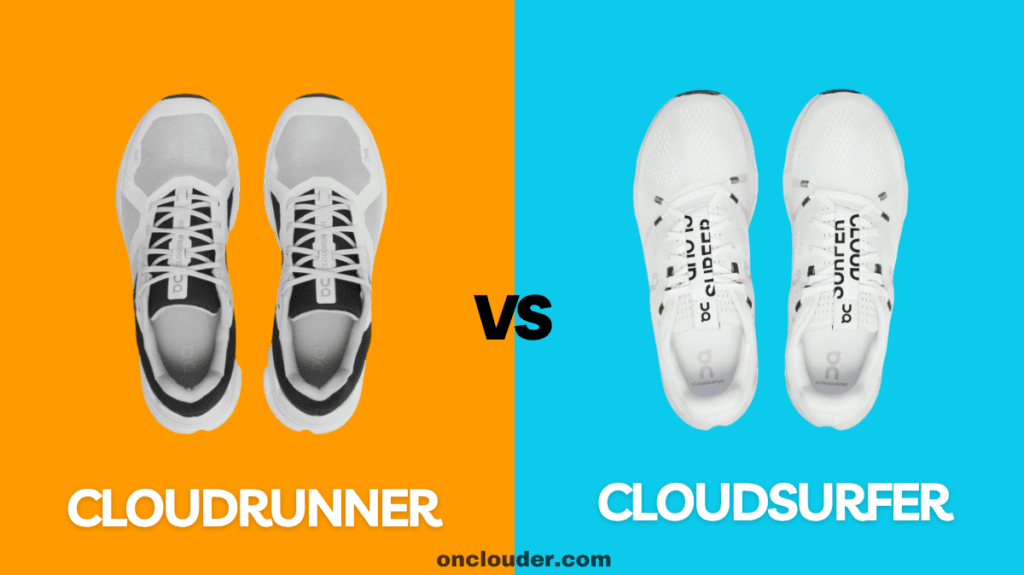
Breathing Easy: Ventilation and Breathability
Nobody likes sweaty feet during a run. Let’s examine how these shoes keep your feet cool and dry:
Cloudrunner Breathability
The Cloudrunner prioritizes comfort for long runs, which includes excellent ventilation:
- Engineered mesh upper allows for constant airflow
- Strategic perforation in key areas
- Moisture-wicking liner helps manage sweat
Cloudsurfer Breathability
The Cloudsurfer’s performance focus doesn’t neglect breathability:
- Lightweight, open-weave mesh upper
- Minimal overlays to maximize air circulation
- Quick-drying materials to keep feet dry during intense workouts
Cushioning: The Heart of Comfort
On Running’s CloudTec® is at the core of both shoes, but how does the cushioning compare?
Cloudrunner Cushioning
The Cloudrunner is all about max comfort:
- Larger CloudTec® elements for increased shock absorption
- Softer foam compound for a plush feel
- Extended cushioning in the heel for impact protection
Cloudsurfer Cushioning
The Cloudsurfer balances cushioning with responsiveness:
- Firmer CloudTec® elements for better energy return
- Strategically placed cushioning for efficient foot strikes
- Helion™ superfoam for a springy feel
Also Read: Cloudrunner vs Cloudflyer
Finding the Right Fit
A proper fit is crucial for comfort and performance. Here’s how these models measure up:
Cloudrunner Fit
The Cloudrunner offers a accommodating fit:
- Wider toe box for natural toe splay
- Secure midfoot wrap for stability
- Slightly more volume in the upper for comfort
Cloudsurfer Fit
The Cloudsurfer provides a more performance-oriented fit:
- Snug midfoot and heel for a locked-in feel
- Slightly narrower profile for a precise fit
- Flexible upper that adapts to foot shape
Stability: Keeping You Steady
Stability can make or break your running experience. Let’s compare:
Cloudrunner Stability
The Cloudrunner is designed with stability in mind:
- Wider base for increased ground contact
- Guidance Line for smoother transitions
- Supportive sidewalls to prevent excessive pronation
Cloudsurfer Stability
The Cloudsurfer offers a different approach to stability:
- Lower profile for better ground feel
- Responsive CloudTec® for quick adjustments
- Snug fit to minimize in-shoe movement
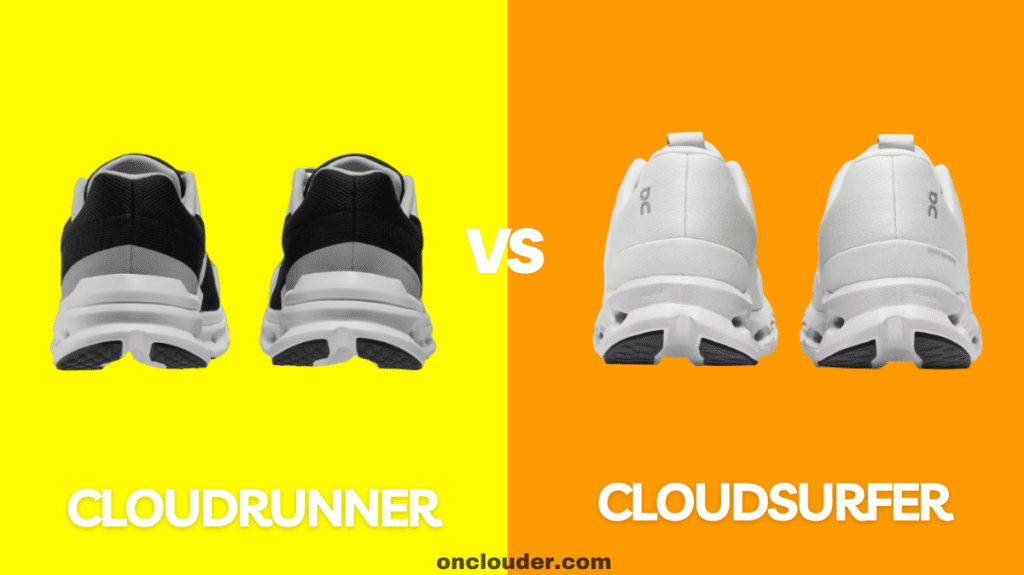
Comfort: All-Day Wearability
Comfort is subjective, but certain features contribute to a shoe’s overall wearability:
Cloudrunner Comfort
The Cloudrunner excels in all-day comfort:
- Plush tongue and collar padding
- Soft, breathable upper materials
- Generous cushioning throughout
Cloudsurfer Comfort
The Cloudsurfer balances comfort with performance:
- Lightweight feel for extended wear
- Responsive cushioning that doesn’t bottom out
- Adaptive fit that molds to your foot
Quality: Built to Perform
Both shoes showcase On Running’s commitment to quality, but let’s look closer:
Cloudrunner Quality
The Cloudrunner demonstrates quality through:
- Premium materials throughout
- Consistent construction and attention to detail
- Durable components that maintain performance over time
Cloudsurfer Quality
The Cloudsurfer’s quality shines in:
- High-tech materials for performance
- Precision engineering in the midsole
- Reinforced areas for longevity in high-stress zones
Style: Looking Good on the Run
While performance is key, style matters too. Let’s compare the aesthetics:
Cloudrunner Style
The Cloudrunner offers:
- A more substantial, supportive look
- Various color options from subtle to bold
- Reflective elements for visibility
Cloudsurfer Style
The Cloudsurfer presents:
- A sleeker, race-ready appearance
- Dynamic color schemes
- Streamlined design with minimal overlays
Also Read: Cloudrunner vs Cloudgo
Size Matters: Finding Your Fit
Proper sizing is crucial for comfort and performance:
Cloudrunner Sizing
- Tends to run true to size
- Available in a wide range of sizes
- Accommodates orthotics well
Cloudsurfer Sizing
- May run slightly small for some
- Snug fit might require sizing up for wide feet
- Limited width options
Material Matters: What They’re Made Of
The materials used affect performance, durability, and comfort:
Cloudrunner Materials
- Engineered mesh upper for breathability and support
- Helion™ superfoam midsole for cushioning
- Rubber outsole with CloudTec® elements
Cloudsurfer Materials
- Lightweight mesh and synthetic upper
- Helion™ superfoam midsole for responsive cushioning
- Strategic rubber placement on the outsole
Weight: Light on Your Feet
The weight of your running shoes can impact your speed and endurance:
Cloudrunner Weight
- Men’s: Approximately 10.4 oz (295g)
- Women’s: Approximately 8.8 oz (250g)
Cloudsurfer Weight
- Men’s: Approximately 9.7 oz (275g)
- Women’s: Approximately 8.1 oz (230g)
Flexibility: Bend and Flex
A shoe’s flexibility affects your natural foot movement and comfort:
Cloudrunner Flexibility
- Moderate flexibility for a balance of support and natural movement
- Strategic flex grooves in the outsole
- Supportive upper that still allows for foot flexion
Cloudsurfer Flexibility
- Higher degree of flexibility for a more natural ride
- Adaptive upper that moves with your foot
- Flexible outsole design for smooth transitions
Water Resistance: Staying Dry
While neither shoe is fully waterproof, let’s look at how they handle moisture:
Cloudrunner Water Resistance
- Water-repellent upper treatment
- Quick-drying materials
- Drainage through CloudTec® elements
Cloudsurfer Water Resistance
- Minimal water resistance
- Highly breathable upper allows for quick drying
- Open design may allow more water entry
Also Read: Cloudmonster vs Cloudsurfer
Sole Purpose: Traction and Durability
The sole of a running shoe is crucial for traction, durability, and overall performance:
Cloudrunner Sole
- Larger CloudTec® elements for increased cushioning
- Durable rubber compounds in high-wear areas
- Wide base for stability
Cloudsurfer Sole
- Responsive CloudTec® configuration for energy return
- Strategic rubber placement for traction and durability
- Slightly rockered design for smooth transitions
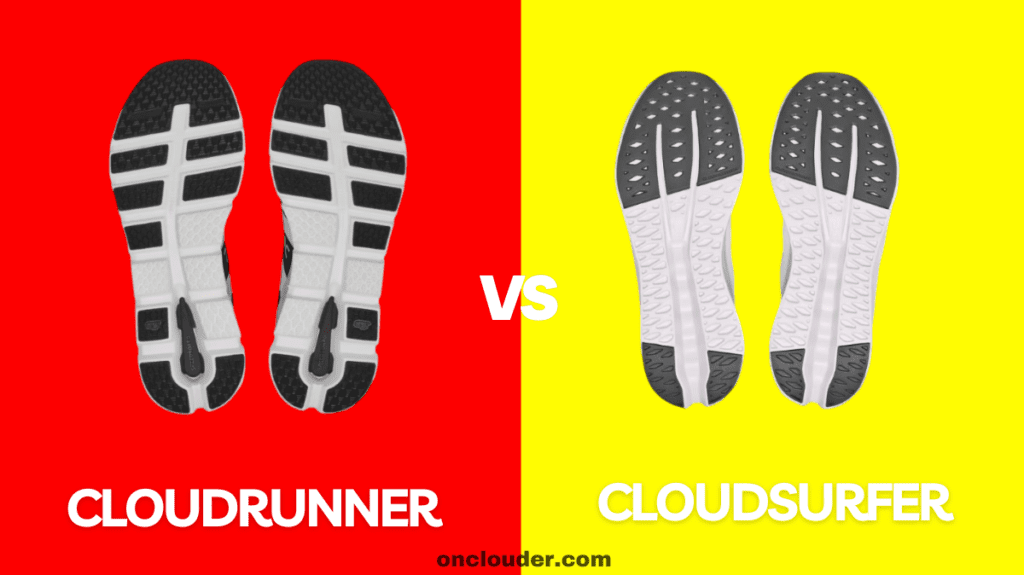
User Reviews: Real Runner Insights
| Aspect | Cloudrunner | Cloudsurfer |
| Comfort | ⭐⭐⭐⭐⭐ | ⭐⭐⭐⭐⭐ |
| Performance | ⭐⭐⭐⭐⭐ | ⭐⭐⭐⭐⭐ |
| Durability | ⭐⭐⭐⭐⭐ | ⭐⭐⭐⭐⭐ |
| Versatility | ⭐⭐⭐⭐⭐ | ⭐⭐⭐⭐⭐ |
| Value for Money | ⭐⭐⭐⭐⭐ | ⭐⭐⭐⭐⭐ |
Price Comparison
Here’s how the Cloudrunner and Cloudsurfer compare in price:
| Model | MSRP (USD) |
| Cloudrunner | $149.99 |
| Cloudsurfer | $159.99 |
Note: Prices may vary depending on retailer and current promotions.
Pros and Cons
Pros: Cloudrunner
- Versatile for various running distances and paces
- Comfortable for daily use and extended wear
- Good balance of cushioning and support
- Suitable for both running and walking
Cons: Cloudrunner
- May feel heavy for speed work or racing
- Less responsive than performance-oriented shoes
- Might be too cushioned for runners preferring a firmer feel
Pros: Cloudsurfer
- Excellent performance for fast-paced runs and races
- Highly responsive with good energy return
- Lightweight design for quick transitions
- Ideal for tempo runs and speed work
Cons: Cloudsurfer
- Less comfortable for long, slow runs or extended walking
- Not as versatile for everyday use
- Firmer cushioning may not suit all-day standing or casual wear
- May wear out faster if used for daily training
Also Read: Cloudultra vs Cloudultra 2
In conclusion: After this detailed comparison, it’s clear that both the Cloudrunner and Cloudsurfer have their strengths. Your choice depends on your specific needs:
Choose the Cloudrunner if:
- You prioritize comfort and cushioning
- You need extra stability for overpronation
- You’re looking for an everyday training shoe
Choose the Cloudsurfer if:
- You want a responsive, performance-oriented shoe
- You prefer a lighter, more flexible ride
- You’re focusing on speed work and racing
Both shoes offer the quality and innovation that On Running is known for. Consider your running goals, foot type, and personal preferences when making your decision.
Are Cloudrunner and Cloudsurfer suitable for beginners?
Yes, both can work for beginners. The Cloudrunner might be more comfortable for those just starting out, while the Cloudsurfer could appeal to beginners with some running experience looking for a performance shoe.
Can I use these shoes for other activities besides running?
While designed primarily for running, both shoes can be used for general fitness activities. The Cloudrunner may be more versatile for all-day wear.
How often should I replace my Cloudrunners or Cloudsurfers?
Generally, replace your running shoes every 400-500 miles. The Cloudrunner may last slightly longer due to its durable construction.
Are these shoes good for marathons?
The Cloudrunner is better suited for marathon distances due to its superior cushioning. The Cloudsurfer is more appropriate for shorter races or for experienced marathoners who prefer a responsive shoe.
Do these shoes work well for people with wide feet?
The Cloudrunner offers a wider fit and may be more comfortable for those with wide feet. The Cloudsurfer has a narrower profile and may require sizing up for wide-footed runners.


